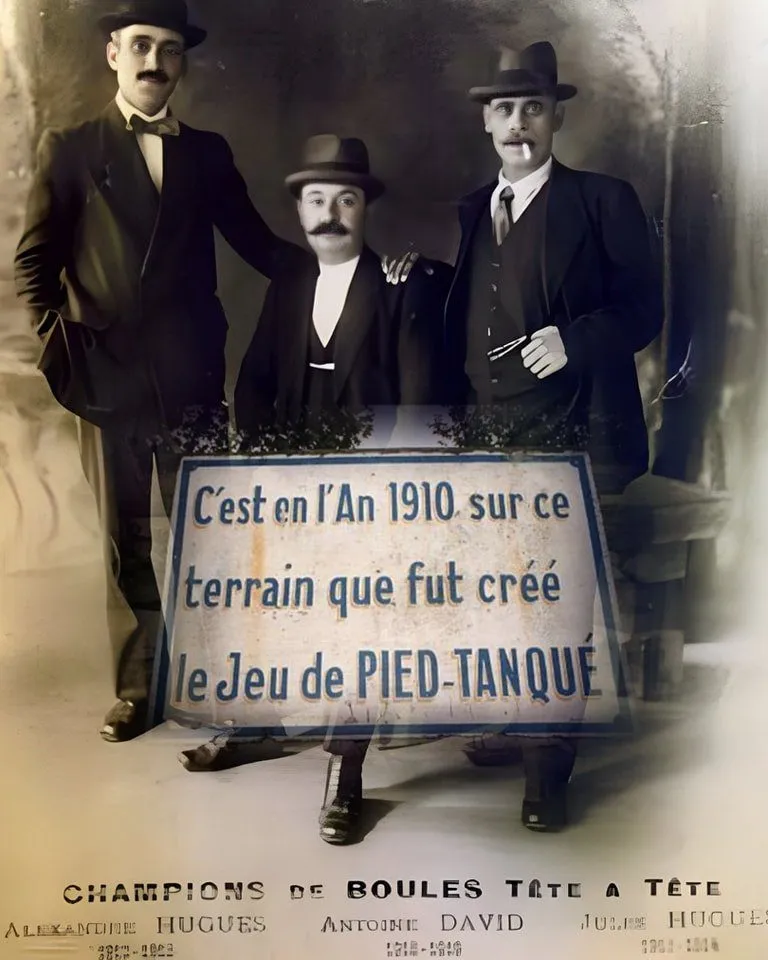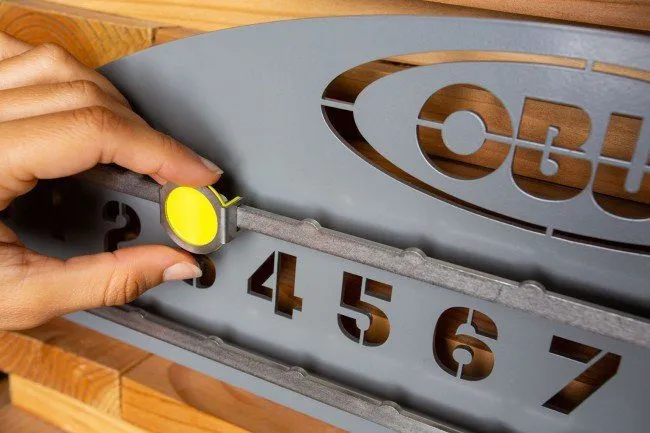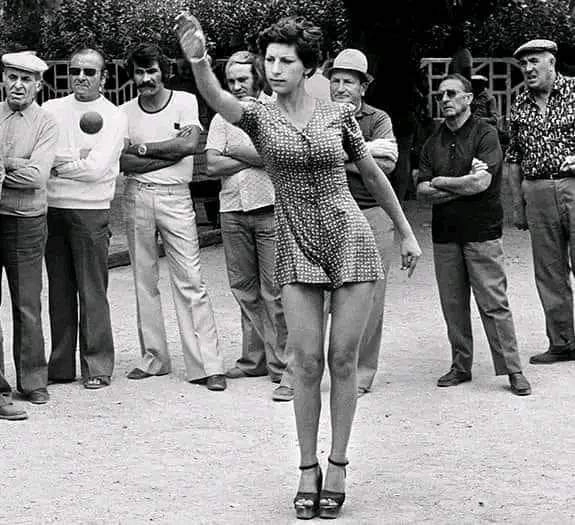

La Pétanqueoften associated with sunny afternoons with friends and family, is much more than just a leisure activity. This jeu de boulescombines precision, strategy and conviviality. With its simple rules and relaxed atmosphere Pétanque has become a sport in its own right.
Pétanque, a boules game of Provencal origin, is an activity that begins with a few crucial steps to ensure a fair and exciting game. From the drawing of lots to determine which team will throw the cochonnet to the throwing of the goal itself, also known as the bouchon or petit, each phase is important and demands particular attention from the players.
The Draw Before the game begins, it’s essential to determine which team will have the honor of throwing the jack first. In official competitions, a coin toss is usually carried out to ensure impartiality. If no coin is available, an alternative is to draw lots by tossing the jack, and the team whose first ball is closest to the jack starts the game.
Setting up the circle Once the team has been designated to throw the jack, a circle 50 cm in diameter is drawn or placed on the ground. All players must stand within this circle before throwing their ball. It’s important to note that handicapped players or those in wheelchairs must also respect this rule, by placing the circle so that at least one wheel (that of the throwing arm) is inside the circle.
The Goal Throw The first player throws thejack or goal from a distance of between 6 and 10 meters from the throwing circle. It is imperative that the jack be marked on the ground after each of its possible movements, be positioned at least 50 cm from any obstacle, from the baseline and 1.50 meters from an adjacent circle. The distance from the inner edge of the throwing circle must be :
– from 4 to 7 metres for Benjamins
– 5 to 8 metres for Minimes,
– 6 to 9 metres for Cadets.
– 6 to 10 metres for Juniors, Seniors and Veterans.
At the next lead, the goal is thrown from a circle drawn or laid around the point where it was at the previous lead, except in the following cases: The circle would be less than 1 meter from an obstacle, 1.50 meters from a circle or a goal in use.
Time limit for the throw Each player has 1 minute maximum to throw the jack and his ball after positioning himself in the circle. This time limit ensures that the game runs smoothly, avoiding excessive delays between throws and maintaining a steady pace of play.
The game of Pétanque is imbued with a subtle strategy, where players must choose between“shooting” or“pointing” with skill. Shooting consists in dislodging the opponent’s ball with precision, while pointing aims to place one’s own ball as close as possible to the jack or in the area chosen by the team, which is often facing the opponent’s balls.
When a player runs out of balls, his opponent can play all his balls to score as many points as possible. Players’ roles can vary, with some specializing in shooting, others in scoring, and some being versatile.
Each throw is crucial and can be decisive in certain situations. Players track every millimetre as close as possible to the jack to gain the advantage. If the jack is moved outside the field, the lead is drawn. If a team still has balls in hand, it scores as many points as balls remaining. If each team has at least one ball in hand, the lead is cancelled, and the team that threw the goal in the previous lead recovers it and throws it again.
Correction of jack positioning If the jack has not been thrown correctly on the first attempt by the same team, the opposing team has the right to retrieve it and replace it by hand, at its convenience, within the regulation perimeter.
Player positioning After the jack has been thrown, the players prepare to throw their balls, taking it in turns to position themselves in the throwing circle marked out on the floor. Each player must remain within this circle until his or her ball touches the ground. It’s important to respect this rule, otherwise a verbal warning will be issued, and if the offence is repeated, the referee will issue a yellow “rusk”, then an orange “rusk”, resulting in the immediate withdrawal of a ball to be played, then a red “rusk”, resulting in the permanent exclusion of the player concerned. The aim is to guarantee fairness and consistency in the game, avoiding any unfair advantage linked to the positioning of players.
Goal marking After each movement of the jack, its position must be marked to enable players to easily refer to it when throwing balls and in certain game situations. This step ensures smooth, fair play, avoiding any confusion as to where the goal is.
Respecting the rules Throughout the game, it is essential that all players respect the established rules, particularly with regard to throwing from the circle, marking the goal and moving around the pitch. Any player failing to comply with these rules will be subject to penalties in accordance with current regulations. See FFPJP rules
Whether it’s friendly backyard get-togethers, local tournaments or even national and international competitions, Pétanque is the game of choice. Pétanque offers a fun and socially unique experience.
In addition to technical skills, pétanque also encourages teamwork and cohesion, concentration and rapid, shared decision-making. Each game is a new opportunity to strengthen social ties and share moments of pleasure and camaraderie.
The popularity of Pétanque continues to grow, attracting players from all walks of life. Pétanque clubs often provide the ideal setting for learning and perfecting skills, while enjoying the company of other enthusiasts.
Whether it’s for a relaxed afternoon with friends or a fierce competition, the Pétanque remains a timeless game that embodies the spirit of sport, fun and camaraderie. So grab your pétanque balls, find a court and get ready for a game where every throw could bring you one step closer to victory!
There are three official ways to play the game of Pétanque :
At head-to-head Two players compete individually, each with three balls.
At doublette Two teams of two players play against each other, each player having three balls at his disposal, i.e. 6 balls against 6.
At triplette Two teams of three players compete, with each player owning two balls, i.e. 6 balls against 6.
Any other game configuration is forbidden according to the official rules established by the Pétanque Federation (FFPJP).
In a competition, each player uses his or her own pétanque boules. These boules must be made of metal and comply with precise specifications: a diameter diameter of between 70.5 mm and 80 mm, and a weight between 650 grams and 800 grams. Balls are sold in sets of three, and are available in different hardness(Amorti +, very soft, soft, semi-soft or hard). The jack used must be made of wood or synthetic material, weigh between 10 and 18 grams and have a diameter of 30 millimetres.
For informal or leisure games, you can use standard non-approved metal boules, which are less expensive and made in more common dimensions and materials.
Le Pétanque courtis the essential element that defines the atmosphere and quality of a game of Pétanque. With regulation dimensions of 4 meters wide by 15 meters long, although some

from the variations that can be tolerated (with a minimum of 3 meters by 12 meters in some cases), to its floor composition, every detail contributes to the players’ playing experience.
This generous playing area offers enough space for players to compete in optimal conditions. Generally speaking, the flatness of the pitch is also crucial to ensure fair play without major obstacles.
As for the composition of the floor, boulodromes and pétanque courts can be surfaced with a variety of materials. The most common include gravel, red shale, dolomite or sand. Each material offers a different texture and grip, which influences the way the boules react to throwing, hitting and rolling. Some players prefer harder, more selective surfaces like dolomite for better control, while others opt for sand for extra grip.
However, it’s important to note that Pétanque can be played in a variety of environments, even outside official boulodromes. Impromptu pitches in village squares, campsite parking lots, beaches or undergrowth can also host lively games. The key is to ensure that the pitch is relatively flat and safe, to avoid any risk of injury or material damage.
For beginners, a flat, sandy pitch is ideal for learning the game without too much difficulty. This allows players to concentrate on learningthrowing gestures andtechniques. As skills develop, players can gradually venture onto rougher terrain, reinforcing their ability and accuracy.
In short, whether you play on an official boulodrome or on an improvised pitch, the most important thing is to enjoy every moment spent playing Pétanque, sharing moments of conviviality and competition together in a pleasant, safe setting. In 2 words, enjoy!
La Pétanquea boules game steeped in history and tradition, has undergone a remarkable evolution since its official creation in 1907. While preserving its roots and convivial spirit, Pétanque has adapted to modern times, both in terms of rules and equipment.

The history of Pétanque goes back well before its formalization in 1907. Initially known as the“Provençal game“, this activity dates back to the Middle Ages in France. However, it was in 1907, in the Provence region, that Pétanque really took off, thanks to an anecdote that was to change the course of the game.
The origin of the name “Pétanque“is attributed to Jules Hugues, nicknamed “Lenoir”, a famous bouliste of the time. Tired of rheumatism, which prevented him from throwing his
boule, he decided one day to remain motionless in the pitching circle, “feet planted in the ground”, during a game at La Ciotat, near Marseille. Thus was born the term “Pétanque“from the Occitan words “pè” meaning “foot” and “tanca” meaning “stake”.
Since then, the Pétanque is played with the feet firmly planted in the ground, without moving when the ball is thrown. This fundamental rule has remained unchanged ever since, testifying to the rich traditions that surround this popular game.
The evolution of Pétanque is not only limited to the rules of the game, but also to the equipment used. Once made of studded wood, the Boules de Pétanque appeared on boulodromes as early as 1927. Today, players can choose between different metals such asstainless steel, carbon or bronze, each offering specific characteristics in terms of rust resistance and grip.
In competition, the rules of pétanque have evolved considerably over the years, with details added to every aspect of the game. These rules, which may be debatable, have not stood still since the creation of the various federations, and continue to be modernized to adapt to contemporary standards while preserving the traditional spirit of the game as much as possible.
All in all Pétanque is much more than just a game of Boules. It’s a cultural heritage, a symbol of conviviality and sharing, whose evolution bears witness to its ability to adapt to the demands of the times, while retaining its fundamental values. Whether on an official boulodrome or in the garden with friends Pétanque continues to unite enthusiasts of all ages and backgrounds around the same timeless passion.

Once all the balls have been thrown, the scoring begins. Only the team’s balls that are closer to the jack than the opposing team’s best ball are counted as points.
Each ball closer to the jack scores a point for the corresponding team. The team that wins the lead scores as many points as the number of balls positioned closer to thejack than the other team’s best ball.
For example, ifteam A has 2 balls closer to the jack thanteam B, it wins 2 points).
If two balls are equidistant from the jack, they cancel each other out and do not count towards the score.
You have to reach 13 points to win the game!

“Fanny à la pétanque” is an expression used in the world of pétanque to designate a situation where a losing team has failed to score a single point in a game. When a team suffers this defeat, players are traditionally required to kiss an image of Fanny’s buttocks, often depicted in the form of a poster or drawing, placed on a wall or object near the playing field.
The origin of this tradition goes back to a French legend according to which a waitress named Fanny, working in a café near a pétanque court, promised a kiss to anyone who lost without scoring a single point.
So kissing Fanny has become a fun and playful ritual in the world of Pétanque.
This tradition contributes to the friendly, relaxed atmosphere often associated with Pétanque, where players can tease and joke with each other, even after defeat.
4 Tips to improve your game
Testimonials
EXCELLENTTrustindex vérifie que la source originale de l'avis est Google. J'ai suivi un stage de 3 jours de pétanque avec Jean-François. C'était formidable du point de vue amélioration de la technique, mental, tactique et plein d'autre astuces pour pouvoir améliorer mon jeu de pétanque. Une atmosphère absolument remarquable avec un entraineur motivé, convivial, plein d'idées, .... Cette formation fantastique me reste toujours dans ma mémoire. Merci Jean-FrancoisTrustindex vérifie que la source originale de l'avis est Google. Jean-François dégage une sympathie naturelle. On se sent tout de suite à l’aise avec lui ! Le stage était passionnant. Mon beau frère qui n’avait quasiment jamais joué a fait des progrès fulgurants ! Je conseille à toutes et tous de tenter l’aventure. On ne regrette absolument pas !Trustindex vérifie que la source originale de l'avis est Google. Tres bonne expérience,super accueil .merci beaucoup. Les repas sont excellents.3 jours de pure bonheurTrustindex vérifie que la source originale de l'avis est Google. Jean-François de pétanque academy est un instructeur génial. Outre qu'il connaisse tous les détails de notre belle pétanque comme il le dit, il en est passionné et sait surtout l'enseigner. J'invite toutes les personnes voulant progresser à le contacter !Trustindex vérifie que la source originale de l'avis est Google. Nous avons énormément apprécié notre journée en votre compagnie et nous nous sentons désormais prêts à entreprendre des parties de pétanque ici au Canada. Votre enseignement et vos conseils ont été précieux, même si nous sommes encore des débutants. Grâce à votre pédagogie, nous avons acquis de solides bases, et nous avons vraiment pris plaisir à apprendre dans une ambiance conviviale. Nous n’hésiterons pas à encourager d’autres apprentis pétanquistes à vous découvrir. Merci encore pour tout ce que vous nous avez transmis et pour votre patience. - We greatly enjoyed our day in your company, and we now feel ready to take on pétanque games here in Canada. Your teaching and advice were invaluable, even though we are still beginners. Thanks to your guidance, we have built a solid foundation, and we truly enjoyed learning in a friendly and relaxed atmosphere. We will not hesitate to encourage other aspiring pétanque players to discover you. Thank you again for everything you have shared with us and for your patience.Trustindex vérifie que la source originale de l'avis est Google. Pétanque academy en quelques mots : passion, partage, performance et convivialité. Si vous aimez la pétanque et que vous souhaitez progressez sur tous les paramètres de jeu, alors n'hésitez pas, c'est l'endroit idéal !Trustindex vérifie que la source originale de l'avis est Google. J ai eu le privilège de rencontrer Jean François cet été à Nantes. C'est une personne accueillante très à l écoute et hyper attentive afin de corriger orienter et permettre lors de stage de réellement progresser dans l objectif que les personnes se sont fixés. De débutant à bon joueur en passant par très bon joueur avec des approches différentes il stimule le joueur à savoir se remettre en question et grâce à son sens de l observation il te permet de régler où réajuster des petits détails oh combien important et qui par habitude est tombé dans l oubli. Je lui souhaite de pouvoir continuer à être disponible pour tout un chacun le plus longtemps possible. Visite complètement improvisée durant laquelle j' ai pu assister à sa façon de travailler et franchement j'ai trouvé ça génial car aucune pression de sa part mais énormément de patience. Un petit bonjour de la Belgique. Bonne soirée à tousTrustindex vérifie que la source originale de l'avis est Google. J’ai effectué un stage de pétanque avec JF en juin 2024, pendant 2 jours. Ça a été une expérience incroyable, j’ai l’impression d’avoir gagné quelques années de pétanque, en 2 journées. Même 3 mois après mon stage en présentiel, JF continue de me suivre, de m’aider à progresser, par vidéo, messages. Le suivi d’après stage est très très agréable et satisfaisant. J’ai repris goût à la pétanque grâce à JF. Merci beaucoup, et je reviendrais très bientôt. 😁Trustindex vérifie que la source originale de l'avis est Google. Comme écrit en février, j'ai suivi un cours juste génial de 3 jours à Nantes avec Jean-François, puis ai adhéré à sa formation en ligne. Je finalise maintenant la vision et la mise en pratique de ses fantastiques vidéos (la rubrique du mental est juste incroyable et nécessite une intense concentration avec prises de notes personnelles). Du coup, je suis devenu un très bon joueur de pétanque convoité par mes partenaires à la mêlée et mon plaisir à pratiquer a décuplé... un immense merci à Jean-François , grâce à lui et à sa méthode, mes heures d'entrainement ont pu aboutir à un grand succès personnel!Trustindex vérifie que la source originale de l'avis est Google. J'ai eu une excellente expérience avec [jean François]. Leur accompagnement en pétanque est de haute qualité, et ils savent vraiment comment aider à améliorer les compétences tout en rendant les sessions amusantes et motivantes. Je recommande vivement leurs services à quiconque souhaite progresser en pétanque !"

Pétanque instructor
Recent articles
Ask Us Your Questions!
Don’t hesitate to ask. We’ll answer all your questions quickly and simply.